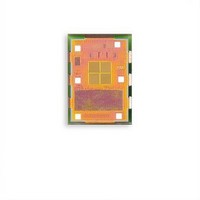TSL2581CS TAOS, TSL2581CS Datasheet - Page 22

TSL2581CS
Manufacturer Part Number
TSL2581CS
Description
Light to Digital Converters Light to Digital 30x Sensitivity
Manufacturer
TAOS
Datasheet
1.TSL2581CS.pdf
(32 pages)
Specifications of TSL2581CS
Data Bus Width
16 bit
Peak Wavelength
625 nm, 850 nm
Maximum Operating Frequency
795 KHz
Operating Supply Voltage
2.7 V to 3.6 V
Operating Current
175 uA
Maximum Operating Temperature
+ 70 C
Minimum Operating Temperature
- 30 C
Interface Type
I2C
Maximum Fall Time
300 ns
Maximum Rise Time
300 ns
Mounting Style
SMD/SMT
Resolution
16 bit
Package / Case
DFN-6
Lead Free Status / RoHS Status
Lead free / RoHS Compliant
Available stocks
Company
Part Number
Manufacturer
Quantity
Price
TSL2580, TSL2581
LIGHT-TO-DIGITAL CONVERTER
TAOS098 − MARCH 2010
Calculating Lux
Simplified Lux Calculation
//****************************************************************************
//
// Copyright 2004−2008 TAOS, Inc.
//
// THIS CODE AND INFORMATION IS PROVIDED ”AS IS” WITHOUT WARRANTY OF ANY
// KIND, EITHER EXPRESSED OR IMPLIED, INCLUDING BUT NOT LIMITED TO THE
// IMPLIED WARRANTIES OF MERCHANTABILITY AND/OR FITNESS FOR A PARTICULAR
// PURPOSE.
//
// Module Name:
// lux.cpp
//
//****************************************************************************
#define LUX_SCALE 16 // scale by 2^16
#define RATIO_SCALE 9 // scale ratio by 2^9
22
Copyright E 2010, TAOS Inc.
The TSL258x is intended for use in ambient light detection applications such as display backlight control, where
adjustments are made to display brightness or contrast based on the brightness of the ambient light, as
perceived by the human eye. Conventional silicon detectors respond strongly to infrared light, which the human
eye does not see. This can lead to significant error when the infrared content of the ambient light is high, such
as with incandescent lighting, due to the difference between the silicon detector response and the brightness
perceived by the human eye.
This problem is overcome in the TSL258x through the use of two photodiodes. One of the photodiodes
(channel 0) is sensitive to both visible and infrared light, while the second photodiode (channel 1) is sensitive
primarily to infrared light. An integrating ADC converts the photodiode currents to digital outputs. Channel 1
digital output is used to compensate for the effect of the infrared component of light on the channel 0 digital
output. The ADC digital outputs from the two channels are used in a formula to obtain a value that approximates
the human eye response in the commonly used Illuminance unit of Lux:
For CH1/CH0 = 0.00 to 0.30
For CH1/CH0 = 0.30 to 0.38
For CH1/CH0 = 0.38 to 0.45
For CH1/CH0 = 0.45 to 0.54
For CH1/CH0 > 0.54
The formulas shown above were obtained by optical testing with fluorescent and incandescent light sources,
and apply only to open-air applications. Optical apertures (e.g. light pipes) will affect the incident light on the
device.
Below is the argument and return value including source code (shown on following page) for calculating lux.
The source code is intended for embedded and/or microcontroller applications. All floating point arithmetic
operations have been eliminated since embedded controllers and microcontrollers generally do not support
these types of operations. Because floating point has been removed, scaling must be performed prior to
calculating illuminance if the integration time is not 400 msec and/or if the gain is not 1× as denoted in the source
code on the following pages
APPLICATION INFORMATION: SOFTWARE
Lux = 0.13 CH0 − 0.24 CH1
Lux = 0.1649 CH0 − 0.3562 CH1
Lux = 0.0974 CH0 − 0.1786 CH1
Lux = 0.062 CH0 − 0.10 CH1
Lux/CH0 = 0
r
www.taosinc.com
r
The LUMENOLOGY r Company





















